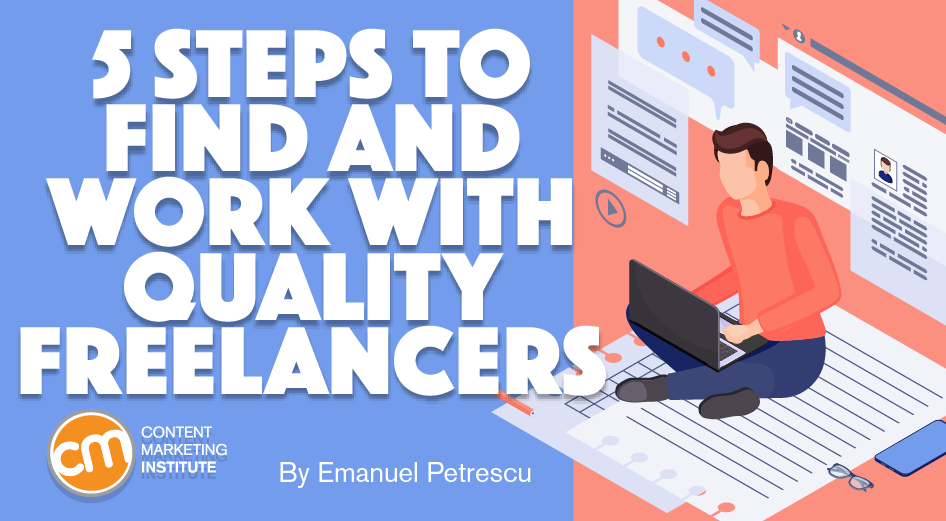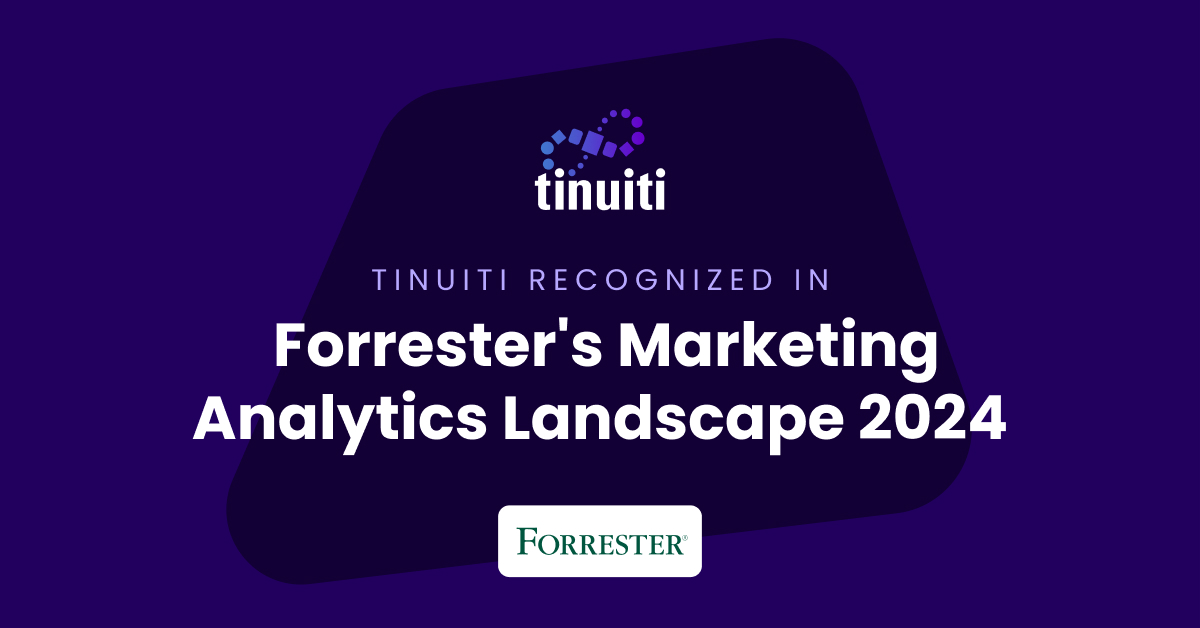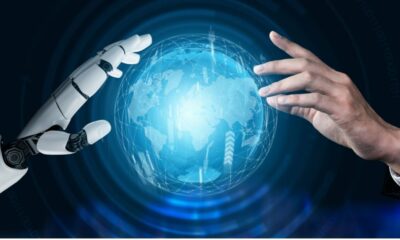MARKETING
5 Steps To Find and Work With Quality Freelancers

Half of marketers say they outsource a content marketing activity. That’s not surprising given about 60% of B2B and B2C marketers operate content marketing teams with no more than five people.
Finding partners with adequate topical experience and who understand the brand’s audience are the most frequently cited challenges in CMI’s most recent research.
Half of #B2B and #B2C marketers say they outsource a #ContentMarketing activity, according to @CMIContent #research. Click To Tweet
To help you overcome those challenges and confidently hire top freelancers, I’ve put together this five-step guide based on my experience working with contract writers.
1. Establish an adequate budget
Before you start the search for writers, you should set a realistic budget.
You can’t simply take a full-time employee’s salary and divide by 40 to estimate a freelancer’s hourly rate. Given freelancers run their own business, they charge more. They have to calculate rates that encompass their expenses – both the employer and employee share of income tax, insurance, and operational costs such as computers, software, internet, etc. Their locale also could affect their rates.
You can’t set a #freelance hourly rate by simply dividing an employee’s weekly compensation by 40, says @emanuelp986 via @CMIContent. #ContentMarketing Click To Tweet
If you’re challenged with finding writers who have sufficient topical experience, budget to pay the higher rates more experienced writers charge. It’s better to have a writer produce a top-notch piece within one or two attempts than to hire a cheaper writer and make multiple corrections.
If you’re challenged with finding writers who have sufficient topical experience, budget to pay the higher rates experienced writers charge, says @emanuelp986 via @CMIContent. #ContentWriting #Freelance Click To Tweet
You should also decide on a budget based on the expected deliverables. The more labor and research-intensive the project, the higher the budget should be.
Rates vary dramatically based on the individual as well as the industry. To calculate your budget, ask peers in your industry what they pay. Look to freelance associations and organizations for benchmark studies.
While a budget sets expectations on how much you can pay the writer, it isn’t the predictor of how successful the relationship will be. That’s why you need to follow the next steps.
2. Create the perfect help-wanted post
Freelance writers carefully read help-wanted posts to assess whether it’s a good opportunity and fit for them. Your listing should clearly explain your expectations and deliverables to attract more qualified responses and accurate proposals.
But just because you’re contracting to work with someone doesn’t mean you need a complete job description as you would with a full-time employee. Among the relevant details to include:
- Assignment description, including what information will be provided by the company and what information the writer is expected to find.
- Specify any special knowledge or skills needed
- Expected deliverables, including length estimate
- Start and end dates, including interim deadlines
- Compensation range with terms like hourly rates or fixed prices as well as invoice payment timing
It helps to add some personality to your listing as it gives the freelancer an idea of what it would be like to work with you. And most importantly, don’t hesitate to ask additional questions you deem necessary to find the ideal candidate for your work.
Add some personality to your #freelance help-wanted listings to give an idea of what it’s like to work with your brand, says @emanuelp986 via @CMIContent. #ContentWriting Click To Tweet
TIP: To assess how well they follow instructions, include a small “test” such as, “Please put the word ‘freelancer’ in your subject line.”
ADVERTISEMENT
Definitive Guide to Content Operations
Get a deep dive into Content Operations: what it is, why it’s so important for organizations in every industry to embrace, what it’s capable of, and how you can build the best content operations solution for your teams. Download now.
3. Locate the best writer for your brand
It’s so much easier these days to reach out and find quality writers for your task or project. Among the options:
- Ask your professional and personal network for referrals. Their input is invaluable because they already have a familiarity with or have worked with the suggested writers. Those word-of-mouth referrals give the candidates an added boost from the beginning.
- Turn to job boards. While many writers search job boards for permanent gigs, part-time writers also use them to find work. Make it clear in your listing that you’re seeking someone for part-time work.
- Post on social media. Post the opportunity to Instagram and Twitter, and use industry-relevant hashtags as well as #Freelance. Posting to relevant social media groups also can be a great way to reach writers in a specific niche.
- Go to freelance sites. Use platforms, such as Contently, Skyword, ClearVoice, etc. These outlets facilitate finding, hiring, and paying writers. Most of the platforms help you quickly find better quality content creators who produce optimal quality work in your niche or for the content type you want created. (I recently hired a writer who specialized exclusively in the privacy policy and terms of use pages.)
Go to #freelance sites such as @contently, @skyword, and @clearvoice to find quality #content creators for your brand, says @emanuelp986 via @CMIContent. #ContentWriting Click To Tweet
TIP: Create an authentic and engaging profile on freelance sites to show your brand’s personality and culture that will attract writers who are interested in that environment.
TIP: If you hire a writer who only freelances part-time, recognize it may take them longer to complete the work than if they worked a full-time freelance writing schedule.
4. Evaluate the writing candidates
First, you should shortlist your options. You can then ignore responses that didn’t pass your test, such as including “freelance” in the subject line. Then, go through the remaining responses and eliminate those who don’t meet the basic requirements.
Freelance platforms also help you find qualified wordsmiths by filtering them based on specific prerequisites and only invite qualified writers to respond to your listing.
With your shortlist identified, conduct a video interview. I do this with every writing opportunity. While phone interviews can work, I find it easier to interact with a person on video.
During the interview, ask them questions to reveal:
- Their professional background and expertise in areas important to your work (i.e., SEO, headline writing)
- Their experience in your niche and with your content type(s)
- How they approach writing assignments such as the ones you would assign
- How they handle meeting deadlines when they are working on multiple projects
- How they respond to unforeseen obstacles, such as an interviewee that doesn’t respond or an unexpected power outage
TIP: Asking for narrative examples sometimes can better help you understand the candidate’s thought process.
If you have a standout candidate, you can proceed to the next step. If you’ve narrowed the search to two or three candidates, ask them to complete a small paid project related to your topic. Then, you can compare and gauge each writer’s ability, from understanding the assignment to executing the content.
Ask the 2 or 3 finalist #freelance candidates to complete a relevant paid assignment to gauge their ability, says @emanuelp986 via @CMIContent. #ContentWriting Click To Tweet
5. Hiring the freelance writer
Once you select the freelance writer to hire, it’s time to detail what you want them to do.
There is a marked difference in hiring a freelancer over an employee. While you tell employees what they have to do and how they have to do it, you can’t give the same instructions to freelancers. They control that.
With freelancers, you should be clear about the criteria, including start date, detailed scope of work, deliverables, payment terms, etc. All these details should be included in a contract, which safeguards your business and the writer, and can help prove to the IRS that the writer is a contractor, not an employee.
A detailed, clear, and concise contract includes:
- Names, contact information
- Exact assignment requirements with deliverables
- Deadlines, including milestones
- Payment terms
- Owner of the completed work
- Confidential information clause
- Limitation of liability
- Freelance copywriter terms and responsibilities
- Indemnity clauses
Don’t begin the working relationship until both parties have signed the contract, and you’ve paid any deposits as required.
TIP: To help your writer onboard more quickly, share examples and documents of similar work so they can better understand your expectations.
TIP: Make sure the writer can access any servers or platforms necessary for their work. It will improve their productivity from the beginning.
HANDPICKED RELATED CONTENT:
Expand your team with freelancers
The process of hiring freelance writers is similar to hiring an employee. You need to know what you want, explain it well in a help-wanted listing, narrow down the candidates, conduct an interview, and then engage your preferred choice.
However, you also need to respect the transactional nature of the relationship. While you can’t control how they do the work, you should spell out exactly what they are to deliver in the formats you prefer and on the schedule you set.
By following this process, you’re more likely to find valuable talent that can help your content marketing team deliver results for your brand.
Cover image by Joseph Kalinowski/Content Marketing Institute
MARKETING
Tinuiti Marketing Analytics Recognized by Forrester

Rapid Media Mix Modeling and Proprietary Tech Transform Brand Performance
Tinuiti, the largest independent full-funnel performance marketing agency, has been included in a recent Forrester Research report titled, “The Marketing Analytics Landscape, Q2 2024.” This report comprehensively overviews marketing analytics markets, use cases, and capabilities. B2C marketing leaders can use this research by Principal Analyst Tina Moffett to understand the intersection of marketing analytics capabilities and use cases to determine the vendor or service provider best positioned for their analytics and insights needs. Moffett describes the top marketing analytics markets as advertising agencies, marketing dashboards and business intelligence tools, marketing measurement and optimization platforms and service providers, and media analytics tools.
As an advertising agency, we believe Tinuiti is uniquely positioned to manage advertising campaigns for brands including buying, targeting, and measurement. Our proprietary measurement technology, Bliss Point by Tinuiti, allows us to measure the optimal level of investment to maximize impact and efficiency. According to the Forrester report, “only 30% of B2C marketing decision-makers say their organization uses marketing or media mix modeling (MMM),” so having a partner that knows, embraces, and utilizes MMM is important. As Tina astutely explains, data-driven agencies have amplified their marketing analytics competencies with data science expertise; and proprietary tools; and tailored their marketing analytics techniques based on industry, business, and data challenges.
Our Rapid Media Mix Modeling sets a new standard in the market with its exceptional speed, precision, and transparency. Our patented tech includes Rapid Media Mix Modeling, Always-on Incrementality, Brand Equity, Creative Insights, and Forecasting – it will get you to your Marketing Bliss Point in each channel, across your entire media mix, and your overall brand performance.
As a marketing leader you may ask yourself:
- How much of our marketing budget should we allocate to driving store traffic versus e-commerce traffic?
- How should we allocate our budget by channel to generate the most traffic and revenue possible?
- How many customers did we acquire in a specific region with our media spend?
- What is the impact of seasonality on our media mix?
- How should we adjust our budget accordingly?
- What is the optimal marketing channel mix to maximize brand awareness?
These are just a few of the questions that Bliss Point by Tinuiti can help you answer.
Learn more about our customer-obsessed, product-enabled, and fully integrated approach and how we’ve helped fuel full-funnel outcomes for the world’s most digital-forward brands like Poppi & Toms.
The Landscape report is available online to Forrester customers or for purchase here.
MARKETING
Ecommerce evolution: Blurring the lines between B2B and B2C

Understanding convergence
B2B and B2C ecommerce are two distinct models of online selling. B2B ecommerce is between businesses, such as wholesalers, distributors, and manufacturers. B2C ecommerce refers to transactions between businesses like retailers and consumer brands, directly to individual shoppers.
However, in recent years, the boundaries between these two models have started to fade. This is known as the convergence between B2B and B2C ecommerce and how they are becoming more similar and integrated.
Source: White Paper: The evolution of the B2B Consumer Buyer (ClientPoint, Jan 2024)
What’s driving this change?
Ever increasing customer expectations
Customers today expect the same level of convenience, speed, and personalization in their B2B transactions as they do in their B2C interactions. B2B buyers are increasingly influenced by their B2C experiences. They want research, compare, and purchase products online, seamlessly transitioning between devices and channels. They also prefer to research and purchase online, using multiple devices and channels.
Forrester, 68% of buyers prefer to research on their own, online . Customers today expect the same level of convenience, speed, and personalization in their B2B transactions as they do in their B2C interactions. B2B buyers are increasingly influenced by their B2C experiences. They want research, compare, and purchase products online, seamlessly transitioning between devices and channels. They also prefer to research and purchase online, using multiple devices and channels
Technology and omnichannel strategies
Technology enables B2B and B2C ecommerce platforms to offer more features and functionalities, such as mobile optimization, chatbots, AI, and augmented reality. Omnichannel strategies allow B2B and B2C ecommerce businesses to provide a seamless and consistent customer experience across different touchpoints, such as websites, social media, email, and physical stores.
However, with every great leap forward comes its own set of challenges. The convergence of B2B and B2C markets means increased competition. Businesses now not only have to compete with their traditional rivals, but also with new entrants and disruptors from different sectors. For example, Amazon Business, a B2B ecommerce platform, has become a major threat to many B2B ecommerce businesses, as it offers a wide range of products, low prices, and fast delivery
“Amazon Business has proven that B2B ecommerce can leverage popular B2C-like functionality” argues Joe Albrecht, CEO / Managing Partner, Xngage. . With features like Subscribe-and-Save (auto-replenishment), one-click buying, and curated assortments by job role or work location, they make it easy for B2B buyers to go to their website and never leave. Plus, with exceptional customer service and promotional incentives like Amazon Business Prime Days, they have created a reinforcing loyalty loop.
And yet, according to Barron’s, Amazon Business is only expected to capture 1.5% of the $5.7 Trillion addressable business market by 2025. If other B2B companies can truly become digital-first organizations, they can compete and win in this fragmented space, too.”
If other B2B companies can truly become digital-first organizations, they can also compete and win in this fragmented space
Joe AlbrechtCEO/Managing Partner, XNGAGE
Increasing complexity
Another challenge is the increased complexity and cost of managing a converging ecommerce business. Businesses have to deal with different customer segments, requirements, and expectations, which may require different strategies, processes, and systems. For instance, B2B ecommerce businesses may have to handle more complex transactions, such as bulk orders, contract negotiations, and invoicing, while B2C ecommerce businesses may have to handle more customer service, returns, and loyalty programs. Moreover, B2B and B2C ecommerce businesses must invest in technology and infrastructure to support their convergence efforts, which may increase their operational and maintenance costs.
How to win
Here are a few ways companies can get ahead of the game:
Adopt B2C-like features in B2B platforms
User-friendly design, easy navigation, product reviews, personalization, recommendations, and ratings can help B2B ecommerce businesses to attract and retain more customers, as well as to increase their conversion and retention rates.
According to McKinsey, ecommerce businesses that offer B2C-like features like personalization can increase their revenues by 15% and reduce their costs by 20%. You can do this through personalization of your website with tools like Product Recommendations that help suggest related products to increase sales.
Focus on personalization and customer experience
B2B and B2C ecommerce businesses need to understand their customers’ needs, preferences, and behaviors, and tailor their offerings and interactions accordingly. Personalization and customer experience can help B2B and B2C ecommerce businesses to increase customer satisfaction, loyalty, and advocacy, as well as to improve their brand reputation and competitive advantage. According to a Salesforce report, 88% of customers say that the experience a company provides is as important as its products or services.
Market based on customer insights
Data and analytics can help B2B and B2C ecommerce businesses to gain insights into their customers, markets, competitors, and performance, and to optimize their strategies and operations accordingly. Data and analytics can also help B2B and B2C ecommerce businesses to identify new opportunities, trends, and innovations, and to anticipate and respond to customer needs and expectations. According to McKinsey, data-driven organizations are 23 times more likely to acquire customers, six times more likely to retain customers, and 19 times more likely to be profitable.
What’s next?
The convergence of B2B and B2C ecommerce is not a temporary phenomenon, but a long-term trend that will continue to shape the future of ecommerce. According to Statista, the global B2B ecommerce market is expected to reach $20.9 trillion by 2027, surpassing the B2C ecommerce market, which is expected to reach $10.5 trillion by 2027. Moreover, the report predicts that the convergence of B2B and B2C ecommerce will create new business models, such as B2B2C, B2A (business to anyone), and C2B (consumer to business).
Therefore, B2B and B2C ecommerce businesses need to prepare for the converging ecommerce landscape and take advantage of the opportunities and challenges it presents. Here are some recommendations for B2B and B2C ecommerce businesses to navigate the converging landscape:
- Conduct a thorough analysis of your customers, competitors, and market, and identify the gaps and opportunities for convergence.
- Develop a clear vision and strategy for convergence, and align your goals, objectives, and metrics with it.
- Invest in technology and infrastructure that can support your convergence efforts, such as cloud, mobile, AI, and omnichannel platforms.
- Implement B2C-like features in your B2B platforms, and vice versa, to enhance your customer experience and satisfaction.
- Personalize your offerings and interactions with your customers, and provide them with relevant and valuable content and solutions.
- Leverage data and analytics to optimize your performance and decision making, and to innovate and differentiate your business.
- Collaborate and partner with other B2B and B2C ecommerce businesses, as well as with other stakeholders, such as suppliers, distributors, and customers, to create value and synergy.
- Monitor and evaluate your convergence efforts, and adapt and improve them as needed.
By following these recommendations, B2B and B2C ecommerce businesses can bridge the gap between their models and create a more integrated and seamless ecommerce experience for their customers and themselves.
MARKETING
Streamlining Processes for Increased Efficiency and Results

How can businesses succeed nowadays when technology rules? With competition getting tougher and customers changing their preferences often, it’s a challenge. But using marketing automation can help make things easier and get better results. And in the future, it’s going to be even more important for all kinds of businesses.
So, let’s discuss how businesses can leverage marketing automation to stay ahead and thrive.
Benefits of automation marketing automation to boost your efforts
First, let’s explore the benefits of marketing automation to supercharge your efforts:
Marketing automation simplifies repetitive tasks, saving time and effort.
With automated workflows, processes become more efficient, leading to better productivity. For instance, automation not only streamlines tasks like email campaigns but also optimizes website speed, ensuring a seamless user experience. A faster website not only enhances customer satisfaction but also positively impacts search engine rankings, driving more organic traffic and ultimately boosting conversions.
Automation allows for precise targeting, reaching the right audience with personalized messages.
With automated workflows, processes become more efficient, leading to better productivity. A great example of automated workflow is Pipedrive & WhatsApp Integration in which an automated welcome message pops up on their WhatsApp
within seconds once a potential customer expresses interest in your business.
Increases ROI
By optimizing campaigns and reducing manual labor, automation can significantly improve return on investment.
Leveraging automation enables businesses to scale their marketing efforts effectively, driving growth and success. Additionally, incorporating lead scoring into automated marketing processes can streamline the identification of high-potential prospects, further optimizing resource allocation and maximizing conversion rates.
Harnessing the power of marketing automation can revolutionize your marketing strategy, leading to increased efficiency, higher returns, and sustainable growth in today’s competitive market. So, why wait? Start automating your marketing efforts today and propel your business to new heights, moreover if you have just learned ways on how to create an online business
How marketing automation can simplify operations and increase efficiency
Understanding the Change
Marketing automation has evolved significantly over time, from basic email marketing campaigns to sophisticated platforms that can manage entire marketing strategies. This progress has been fueled by advances in technology, particularly artificial intelligence (AI) and machine learning, making automation smarter and more adaptable.
One of the main reasons for this shift is the vast amount of data available to marketers today. From understanding customer demographics to analyzing behavior, the sheer volume of data is staggering. Marketing automation platforms use this data to create highly personalized and targeted campaigns, allowing businesses to connect with their audience on a deeper level.
The Emergence of AI-Powered Automation
In the future, AI-powered automation will play an even bigger role in marketing strategies. AI algorithms can analyze huge amounts of data in real-time, helping marketers identify trends, predict consumer behavior, and optimize campaigns as they go. This agility and responsiveness are crucial in today’s fast-moving digital world, where opportunities come and go in the blink of an eye. For example, we’re witnessing the rise of AI-based tools from AI website builders, to AI logo generators and even more, showing that we’re competing with time and efficiency.
Combining AI-powered automation with WordPress management services streamlines marketing efforts, enabling quick adaptation to changing trends and efficient management of online presence.
Moreover, AI can take care of routine tasks like content creation, scheduling, and testing, giving marketers more time to focus on strategic activities. By automating these repetitive tasks, businesses can work more efficiently, leading to better outcomes. AI can create social media ads tailored to specific demographics and preferences, ensuring that the content resonates with the target audience. With the help of an AI ad maker tool, businesses can efficiently produce high-quality advertisements that drive engagement and conversions across various social media platforms.
Personalization on a Large Scale
Personalization has always been important in marketing, and automation is making it possible on a larger scale. By using AI and machine learning, marketers can create tailored experiences for each customer based on their preferences, behaviors, and past interactions with the brand.
This level of personalization not only boosts customer satisfaction but also increases engagement and loyalty. When consumers feel understood and valued, they are more likely to become loyal customers and brand advocates. As automation technology continues to evolve, we can expect personalization to become even more advanced, enabling businesses to forge deeper connections with their audience. As your company has tiny homes for sale California, personalized experiences will ensure each customer finds their perfect fit, fostering lasting connections.
Integration Across Channels
Another trend shaping the future of marketing automation is the integration of multiple channels into a cohesive strategy. Today’s consumers interact with brands across various touchpoints, from social media and email to websites and mobile apps. Marketing automation platforms that can seamlessly integrate these channels and deliver consistent messaging will have a competitive edge. When creating a comparison website it’s important to ensure that the platform effectively aggregates data from diverse sources and presents it in a user-friendly manner, empowering consumers to make informed decisions.
Omni-channel integration not only betters the customer experience but also provides marketers with a comprehensive view of the customer journey. By tracking interactions across channels, businesses can gain valuable insights into how consumers engage with their brand, allowing them to refine their marketing strategies for maximum impact. Lastly, integrating SEO services into omni-channel strategies boosts visibility and helps businesses better understand and engage with their customers across different platforms.
The Human Element
While automation offers many benefits, it’s crucial not to overlook the human aspect of marketing. Despite advances in AI and machine learning, there are still elements of marketing that require human creativity, empathy, and strategic thinking.
Successful marketing automation strikes a balance between technology and human expertise. By using automation to handle routine tasks and data analysis, marketers can focus on what they do best – storytelling, building relationships, and driving innovation.
Conclusion
The future of marketing automation looks promising, offering improved efficiency and results for businesses of all sizes.
As AI continues to advance and consumer expectations change, automation will play an increasingly vital role in keeping businesses competitive.
By embracing automation technologies, marketers can simplify processes, deliver more personalized experiences, and ultimately, achieve their business goals more effectively than ever before.
-

 SEARCHENGINES6 days ago
SEARCHENGINES6 days agoGoogle Core Update Volatility, Helpful Content Update Gone, Dangerous Google Search Results & Google Ads Confusion
-

 SEO6 days ago
SEO6 days ago10 Paid Search & PPC Planning Best Practices
-

 MARKETING7 days ago
MARKETING7 days ago2 Ways to Take Back the Power in Your Business: Part 2
-

 MARKETING5 days ago
MARKETING5 days ago5 Psychological Tactics to Write Better Emails
-

 SEARCHENGINES5 days ago
SEARCHENGINES5 days agoWeekend Google Core Ranking Volatility
-

 MARKETING6 days ago
MARKETING6 days agoThe power of program management in martech
-

 SEO5 days ago
SEO5 days agoWordPress Releases A Performance Plugin For “Near-Instant Load Times”
-

 PPC7 days ago
PPC7 days agoCritical Display Error in Brand Safety Metrics On Twitter/X Corrected














You must be logged in to post a comment Login